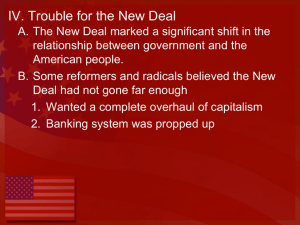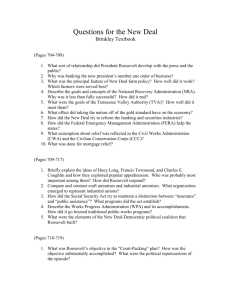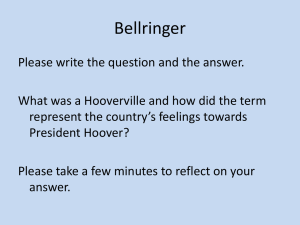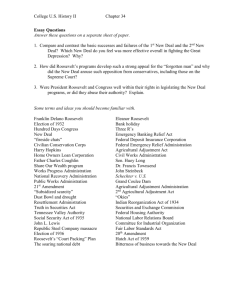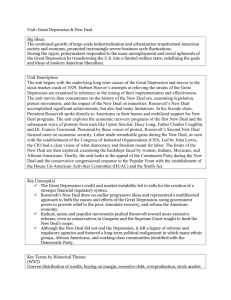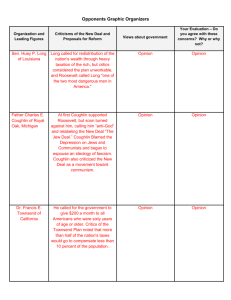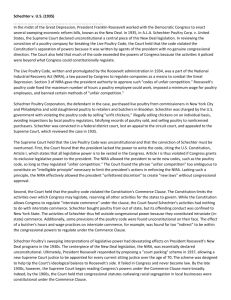THE NEW DEAL COMES UNDER ATTACK Background – By the
advertisement
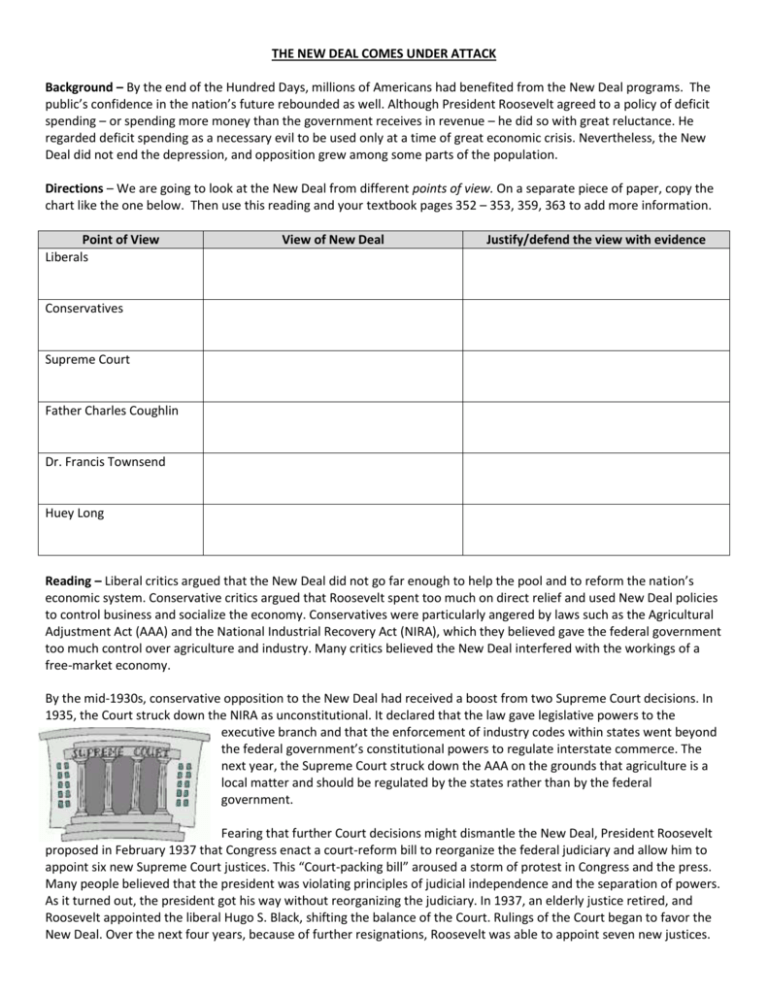
THE NEW DEAL COMES UNDER ATTACK Background – By the end of the Hundred Days, millions of Americans had benefited from the New Deal programs. The public’s confidence in the nation’s future rebounded as well. Although President Roosevelt agreed to a policy of deficit spending – or spending more money than the government receives in revenue – he did so with great reluctance. He regarded deficit spending as a necessary evil to be used only at a time of great economic crisis. Nevertheless, the New Deal did not end the depression, and opposition grew among some parts of the population. Directions – We are going to look at the New Deal from different points of view. On a separate piece of paper, copy the chart like the one below. Then use this reading and your textbook pages 352 – 353, 359, 363 to add more information. Point of View Liberals View of New Deal Justify/defend the view with evidence Conservatives Supreme Court Father Charles Coughlin Dr. Francis Townsend Huey Long Reading – Liberal critics argued that the New Deal did not go far enough to help the pool and to reform the nation’s economic system. Conservative critics argued that Roosevelt spent too much on direct relief and used New Deal policies to control business and socialize the economy. Conservatives were particularly angered by laws such as the Agricultural Adjustment Act (AAA) and the National Industrial Recovery Act (NIRA), which they believed gave the federal government too much control over agriculture and industry. Many critics believed the New Deal interfered with the workings of a free-market economy. By the mid-1930s, conservative opposition to the New Deal had received a boost from two Supreme Court decisions. In 1935, the Court struck down the NIRA as unconstitutional. It declared that the law gave legislative powers to the executive branch and that the enforcement of industry codes within states went beyond the federal government’s constitutional powers to regulate interstate commerce. The next year, the Supreme Court struck down the AAA on the grounds that agriculture is a local matter and should be regulated by the states rather than by the federal government. Fearing that further Court decisions might dismantle the New Deal, President Roosevelt proposed in February 1937 that Congress enact a court-reform bill to reorganize the federal judiciary and allow him to appoint six new Supreme Court justices. This “Court-packing bill” aroused a storm of protest in Congress and the press. Many people believed that the president was violating principles of judicial independence and the separation of powers. As it turned out, the president got his way without reorganizing the judiciary. In 1937, an elderly justice retired, and Roosevelt appointed the liberal Hugo S. Black, shifting the balance of the Court. Rulings of the Court began to favor the New Deal. Over the next four years, because of further resignations, Roosevelt was able to appoint seven new justices. Three Fiery Critics – In 1934, some of the strongest conservative opponents of the New Deal banded together to form an organization called the American Liberty League. The American Liberty League opposed New Deal measures that it believed violated respect for the rights of individuals and property. Three of the toughest critics the president faced, however, were three men who expressed views that appealed to poor Americans: Charles Coughlin, Dr. Francis Townsend, and Huey Long. Every Sunday, Father Charles Coughlin, a Roman Catholic priest from a suburb of Detroit, broadcast radio sermons that combined economic, political, and religious ideas. Initially a supporter of the New Deal, Coughlin soon turned against Roosevelt. He favored a guaranteed annual income and the nationalization of banks. At the height of his popularity, Father Coughlin claimed a radio audience of as many as 40-45 million people, but his increasing antiSemitic (anti-Jewish) views eventually cost him support. Another critic of New Deal policies was Dr. Francis Townsend, a physician and health officer in Long Beach, California. He believed that Roosevelt wasn’t doing enough to help the poor and elderly, so he devised a pension plan that would provide monthly benefits to the aged. The plan found strong backing among the elderly, thus undermining their support for Roosevelt. Perhaps the most serious challenge to the New Deal came from Senator Huey Long of Louisiana. Like Coughlin, Long was an early supporter of the New Deal, but he too, turned against Roosevelt. Eager to win the presidency for himself, Long proposed a nationwide social program called ShareOur-Wealth. Under the banner “Every Man a King,” he promised something for everyone. “We owe debts in America today, public & private, amounting to $252 billion. That means that every child is born with a $2000 debt tied around his neck… We propose that children shall be born in a land of opportunity, guaranteed a home, food, clothes, and the other things that make for living, including the right to education.” – Huey Long Long’s program was so popular that by 1935 he boasted of having perhaps as many as 27,000 Share-Our-Wealth clubs and 7.5 million members. That same year, however, at the height of his popularity, Long was assassinated by a lone gunman. Concluding Activities – Under your critics chart, complete the following in complete sentences. You do not have to copy the question. 1. Of the various points of view, which one do you think was most justified? (i.e. If you were alive during the Depression, who do you think you would have agreed with?) Explain. 2. Of the various points of view, with which one do you disagree? Explain. 3. Look at the political cartoon on page 352 & answer the following a. What does this cartoon suggest is happening to Uncle Guinea Pig? b. Does this cartoon present a positive view of the New Deal? Explain.
